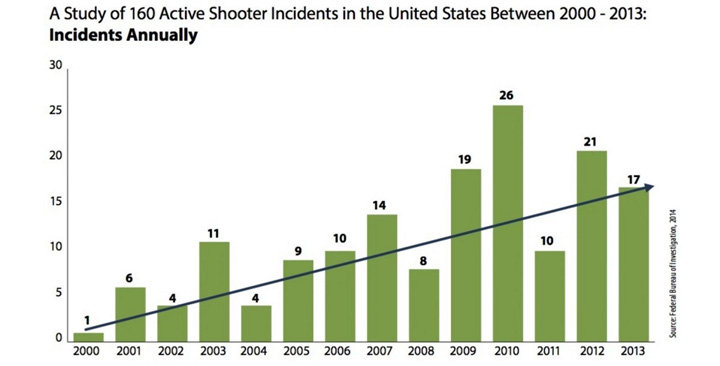Mass shootings in America escalated between 2000-2013
- FBI study reports 160 incidents, 486 killed, and 557 wounded.
- Has our changing culture created these mass shootings?
- What can be done to restore our values and attitudes?

FBI Active Shooter Study 2000 – 2013
- Our guest is a violence threat assessment expert James S. Cawood.
Podcast Time Stamps:
[03:55] – Mass shootings: mental health, gun control, or immigration.
[05:00] – Introduction of threat assessment expert Jim Cawood.
[08:20] – Discussion about FBI 2000-2013 active shooter study.
[11:00] – Mass shootings don’t seem connected to an economic downturn.
[11:45] – Mass shootings connected to perception, narcissism, depression.
[13:00] – Changing psycho-social forces will affect the rate of future incidents.
[16:00] – Until San Bernardino majority of mass shootings were not jihad.
[06:02] – The majority of mass shootings are committed by lone male shooters.
[18:30] – Will future mass shootings involve women or be gender-neutral?
[18:40] – The narcissism epidemic causes men to be wounded and reactive.
[21:30] – Are mass shootings linked to first-person shooter video games?
[25:50] – Is media coverage contributing to mass shootings payoff?
[28:35] – Mass shootings are psychological and sociological issues.
Mass Shootings Facts
- Mass shootings rose while the single homicide rate has declined last decade.
- The timing of mass shootings has not coincided with a downturn in the economy.
- The rhythm of mass shootings involves perception, narcissism, or depression.
- An expectation of the public is that no mass shootings should occur.
- Since 2000 American mass shooters have been mostly homegrown.
- Female mass shootings are rare, but that may change in the future.
- Being poor or disadvantaged is not an indicator of mass shootings.
- Video games can produce a pseudo-commando game-score mindset.
- Some mass killers study past acts of active shooters to beat their scores.
- Mass shootings view infamy as the most important time of their life.
- Violence occurs in cultures focused on individuals over group collective.
About our guest James S. Cawood
- Jim Cawood is President of Factor One, a California corporation specializing in threat assessment and management, violence risk assessment, and behavioral analysis for more than 25 years.
- He is a practicing security consultant, licensed private investigator, and former police officer.
- He has successfully assessed and managed over 4500 violence-related cases throughout North America.
- Mr. Cawood is a graduate of U.C. Berkeley, holds a Master’s degree in Forensic Psychology from Argosy University, and is a doctoral candidate in Psychology at Northcentral University.
- He has served on the faculties of Golden Gate University, in their Security Management degree program, and the University of California, Santa Cruz extension, teaching Threat Management.
- Mr. Cawood is currently serving on the Editorial Board of the Journal of Threat Assessment and Management (American Psychological Association).
- He is the former Association President of the Association of Threat Assessment Professionals (ATAP).
- Mr. Cawood has earned the Certified Protection Professional (CPP); Professional Certified Investigator (PCI); Physical Security Professional (PSP); Certified Fraud Examiner (CFE); Certified Security Professional (CSP); Certified Professional Investigator (CPI); and a Certified International Investigator (CII).
- He has written articles and book chapters for various professional publications including Security Management magazine.
- The original author of A Plan for Threat Management (Chapter 40) of the Protection of Assets Manual.
- Chapters 24- Personnel Screening and Chapter 32- Arson, Sabotage, and Bomb Threats in the Accident Prevention Manual for Business & Industry- Security Management volume
- Chapter 32- Security for Safety, Health, and Asset Protection: Management Essentials, 2nd Edition.
- Coauthored chapter: Threat Management of Stalking Cases in The Psychology of Stalking: Clinical and Forensic Perspectives, published by Academic Press in 1998.
- Mr. Cawood coauthored a book, Violence Assessment and Intervention: The Practitioner’s Handbook, CRC Press 2003-the 2nd Edition having been published in January 2009.
- He contributed to Ending Campus Violence: New Approaches to Prevention, by Brian Van Brunt, Routledge, August 2012.
- He contributed to Threat Assessment and Management to Applied Crime Analysis: A Social Science Approach to Understanding Crime, Criminals, and Victims, by Wayne Petherick, in July 2014.
Mass Shootings References
- FBI Study of Active Shooter Incidents in the United States 2000-2013.
- Jim Cawood – Coauthor of Violence Risk Assessment – A Practitioners Handbook.
- J. Reid Malloy, Ph.D. – Clinical Professor of Psychiatry at the University of California, San Diego.
- Jean M. Twenge, Ph.D. – Author Narcissism Epidemic – Psychology Professor, San Diego State.
- MacArthur Violence Risk Assessment Study.
- Lt. Col. David Grossman – Killology Research Group.
Learn More about Premises Liability Litigation
Download the 115-page eBook written by Security Expert Chris E. McGoey
- Security Expert’s Guide to Premises Liability Litigation
- Evaluating Crime Foreseeability and Inadequate Security Cases
Chris McGoey has authored a tremendous practical guide about premises liability litigation for attorneys, security consultants, risk managers, landlords, law enforcement, and business operators.
“You won’t find a better book on this subject!”
If you’re a trial lawyer, you simply “Must Read This Book”
- 115 pages 8.5 X 11″ — Instant Download (PDF) – Revised 2023.
Copyright © 2009 – 2023 Aegis Books, Inc.
Click the Buy Now button. Pay via PayPal or Credit-Debit Cards
Instant Download $25 –
- Online Orders are Secure via PayPal Server
- Unconditional Money-Back Guarantee
Biography of Chris E. McGoey
Testimonials from a few clients
Premises Liability Litigation Book
Retain Chris as a Security Expert Witness
Contact Security Consultant Chris E. McGoey
Jonesborough, Tennessee
